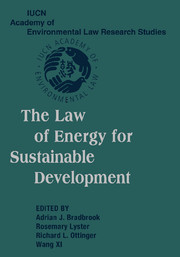Book contents
- Frontmatter
- Contents
- Acknowledgments
- Message from Kofi A. Annan, Secretary-General, United Nations
- Introduction – A Global Learned Society to Address Earth's Evolution: The IUCN Academy of Environmental Law
- Public Lectures on International Environmental Law
- PART ONE SUSTAINABLE DEVELOPMENT AND THE ROLE OF ENERGY LAW
- PART TWO LEGAL ISSUES IN CONTEMPORARY ENERGY LAW
- PART THREE INTERNATIONAL ENERGY LAW
- PART FOUR COMPARATIVE ENERGY LAW
- 18 UNDP: China's Energy Portfolio
- 19 Implementing the Kyoto Protocol beyond the WSSD at Johannesburg – The Japanese Perspective
- 20 Strategy, Policy, and Law Promoting Renewable Energy Resources in China
- 21 Energy Development and Utilization in Africa
- 22 European Energy Law Initiatives
- 23 The Law of Energy for Sustainable Development in Britain
- PART FIVE ELECTRICITY RESTRUCTURING
- PART SIX FINANCING FOR SUSTAINABLE ENERGY
- PART SEVEN CIVIL SOCIETY AND THE PROCEDURAL REQUIREMENTS OF ENERGY LAW FOR SUSTAINABLE DEVELOPMENT
- Index
22 - European Energy Law Initiatives
Published online by Cambridge University Press: 10 August 2009
- Frontmatter
- Contents
- Acknowledgments
- Message from Kofi A. Annan, Secretary-General, United Nations
- Introduction – A Global Learned Society to Address Earth's Evolution: The IUCN Academy of Environmental Law
- Public Lectures on International Environmental Law
- PART ONE SUSTAINABLE DEVELOPMENT AND THE ROLE OF ENERGY LAW
- PART TWO LEGAL ISSUES IN CONTEMPORARY ENERGY LAW
- PART THREE INTERNATIONAL ENERGY LAW
- PART FOUR COMPARATIVE ENERGY LAW
- 18 UNDP: China's Energy Portfolio
- 19 Implementing the Kyoto Protocol beyond the WSSD at Johannesburg – The Japanese Perspective
- 20 Strategy, Policy, and Law Promoting Renewable Energy Resources in China
- 21 Energy Development and Utilization in Africa
- 22 European Energy Law Initiatives
- 23 The Law of Energy for Sustainable Development in Britain
- PART FIVE ELECTRICITY RESTRUCTURING
- PART SIX FINANCING FOR SUSTAINABLE ENERGY
- PART SEVEN CIVIL SOCIETY AND THE PROCEDURAL REQUIREMENTS OF ENERGY LAW FOR SUSTAINABLE DEVELOPMENT
- Index
Summary
INTRODUCTION
To evaluate European environmental policy initiatives in general and renewable energy initiatives in particular, it is necessary to take into account the links between energy policy, ecological tax policy, climate change policy, and strategies for sustainability in general. Looking at Europe, leading examples can be seen in each of these policy areas; moreover, significant variations can be seen between member states. For instance, Germany provides leading examples of energy and climate change policies, whereas in other fields such as ecological taxation, the Scandinavians and the Dutch took and still hold the leading position while Germany is catching up at best. It is doubtful whether Germany has a clear sustainability strategy in place. For the purposes of this chapter, “sustainability” means more than environmental policy; it also involves good education policies, intergenerational equity, and social cohesion. Again in this context, the sustainability strategies currently in place in Scandinavia are further advanced than German policies. Germany also is lagging behind in certain areas, particularly education policies.
This chapter will concentrate on energy policy and draw certain cross connections to climate policy, a closely related policy area. It will cover legal as well as factual developments. Within the broad parameters of energy policy, this chapter will concentrate first, on the supply of electricity produced from renewable sources and second, on how such strategies can operate as a means for reducing greenhouse gas emissions in order to achieve the aims of the Kyoto Protocol.
- Type
- Chapter
- Information
- The Law of Energy for Sustainable Development , pp. 370 - 394Publisher: Cambridge University PressPrint publication year: 2005



